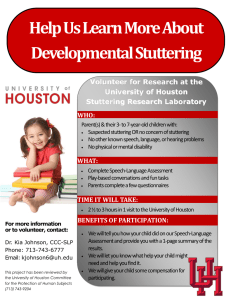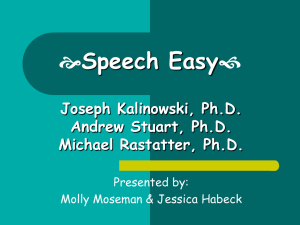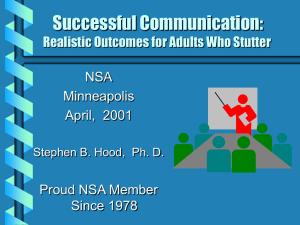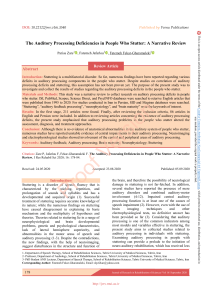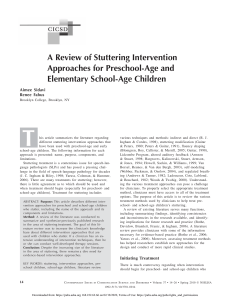SpeechEasy Joseph Kalinowski, Ph.D., Andrew Stuart, Ph.D., and Michael Rastatter, Ph.D.
advertisement
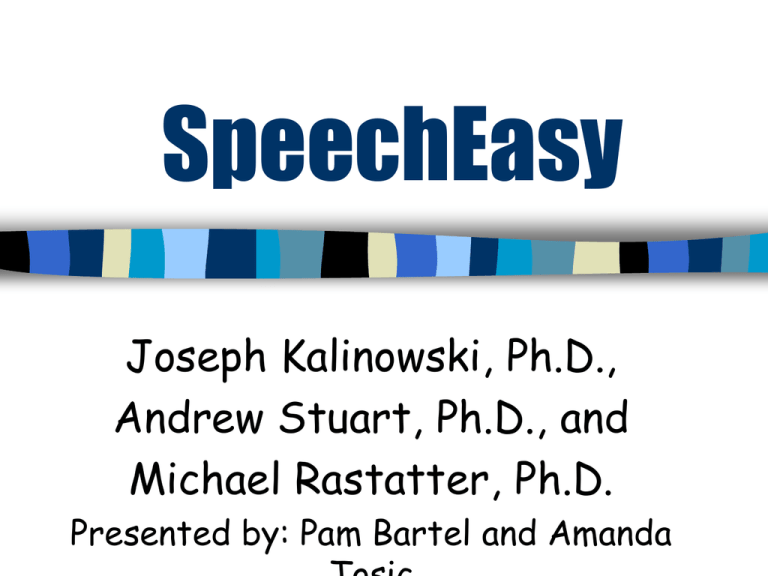
SpeechEasy Joseph Kalinowski, Ph.D., Andrew Stuart, Ph.D., and Michael Rastatter, Ph.D. Presented by: Pam Bartel and Amanda Classification of the SpeechEasy The SpeechEasy can be classified as a form of stuttering modification/reduction. The SpeechEasy uses altered auditory feedback in the form of auditory delays and frequency shifts. It uses choral speech to simulate talking amongst a group of people. Theoretical Rationale The SpeechEasy was based on the connection between stuttering and the neurological coordination of speech. Research has been done for 10 years at East Carolina University. The SpeechEasy was based on 10 years of peer-reviewed scientific research on the effects of altered auditory feedback in people who stutter. Efficacy studies are being conducted at the Stuttering Research Lab. Style of Presentation An individual needs to follow a sequence of events to acquire a device. – – – – – – – – Hearing Test and Ear Impression Stuttering evaluation Device demonstration Counseling Correct Fitting for maximum fluency Decision to purchase Payment Follow-up visit After an individual has been custom fit with their device, fluency effects are seen within 20-90 minutes. Success… How effective is the SpeechEasy? The SpeechEasy has been tested in over 200 people that stutter. The levels of fluency enhancement varied from 50%-95% improvement. A continual enhancement of fluency is expected. Maintenance and Generalization Minimal training may be required by some device users to benefit from the SpeechEasy. The SpeechEasy has a one year warranty for mechanical defects. You can return the device within 30 days if you are not satisfied and you will receive 90% of the purchase price back. Software upgrades are free to current customers to reduce problems with external noise. Individuals can use this device in a variety of settings. For example: talking on the phone, speaking in front of an audience, and ordering at a restaurant. Benefits of the SpeechEasy It has an 80%-90% success rate among 200 patients of all ages who suffer from fluency disorders. The SpeechEasy has a variety of models to best fit an individual’s needs. For example, behind the ear, in the canal, or completely in the canal. Custom modeled to fit comfortably and unnoticeably when worn. Weaknesses of the SpeechEasy Although there has been 10 years of research at East Carolina University, there has been no long term data available concerning Altered Auditory Feedback used with in-the-ear devices. Device may pick up external noise or a person’s own speech, causing distraction. It cannot be considered a cure for stuttering. Personal Recommendations We believe that the SpeechEasy is an option to reduce non-fluent behaviors. The SpeechEasy may be considered to be a supplement to traditional therapy approaches. It cannot be considered as a “quick fix” to cure all stuttering behaviors.
